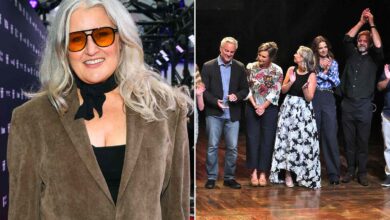The real story behind Marilyn Monroe’s subway grate photo
:max_bytes(150000):strip_icc():format(jpeg)/marilyn-monroe-tout-16f0c63b462040a0bb8e19fffc62a3db.jpg)
NEED TO KNOW
- The family of photographer Sam Shaw, who befriended Marilyn Monroe, released unseen images and letters
- Shaw details how the iconic Monroe subway grate image during The Seven Year Itch really came to be
- The film’s director and producer were “anxious to see how far one could go against censorship”
The man who snapped the career-defining windswept photograph of Marilyn Monroe above a subway grate in the iconic white dress is posthumously detailing exactly how that image came to be.
Photographer Sam Shaw befriended the iconic actress in the early 1950s and soon became her de facto personal photographer. Although he died in 1999, his family unearthed a trove of unseen images and correspondence between the two, which are included in “Dear Marilyn: The Unseen Letters and Photographs.” In the book, Shaw describes the subway grate scene featuring Monroe and actor Tom Ewell in The Seven Year Itch, and its subsequent image was his idea; however, the still image for the movie’s advertisement was actually shot in a Los Angeles studio.
Shaw explains that he shot a photo of a model and a sailor in a very similar pose over a decade prior at the Coney Island Steeplechase Park, and he always figured he’d recreate it on a larger scale. The opportunity arose when he was asked to create a key photo and logo for the film’s promotion.
After reading the script for the 1955 film, Shaw “knew that the scene of Marilyn on Lexington Avenue and 51st Street was the key moment for me to find an ad for the picture,” he writes.
Bruno Bernard © Joshua John Miller
In explaining the concept to the movie studio, the photographer then asked that they “arrange for an additional number of police officers to handle the crowd that was sure to gather.”
“The production manager, John Graham needed several days to set up the logistics—arranging permission to cordon off Lexington Avenue and 51st Street and for a technician to operate a wind machine under the spot where Marilyn would step on the grating grill,” Shaw writes. “The wind machine was to imitate a passing subway train to create the wind to blow her skirt.”
On Sept. 15, 1954, thousands of fans and press members showed up, but the situation remained under control.
“The police were completely off guard, more fascinated watching Marilyn, forgetting the mob. Not one person in the crowd broke through,” Shaw penned. “They were too mesmerized by what they were seeing. [Director Billy Wilder] and [producer Charles Feldman] were both anxious to see how far one could go against censorship. It was the early 1950s and the National Legion of Decency, the puritanical group we called the “Bluenoses” reigned. But Marilyn’s elegance and clean sense of fun, under Wilder’s sensitive and witty direction, controlled the scene—very daring for its time.”
Shaw got his turn after the film crews were finished.
“I had complete freedom to set up my shot. Marilyn loved posing for me in this sequence. When I got directly in front of her, she leaned forward and said, “Hi, Sam Spade.” That was her nickname for me—a reference to Humphrey Bogart’s character in The Maltese Falcon.
“I had enough time that night to shoot and to go down below in the subway tunnel to catch the man at the wind machine underneath the grating. Marilyn enjoyed the whole experience more than anyone—even more than the man below at the wind machine.”
Bettmann/Getty
The photo was syndicated the next day and became known as the “shot seen ’round the world.” Despite the notoriety of the moment, it had to be recreated on the West Coast for the ad and film.
“On account of the rough shooting conditions of location, exterior, crowds, etc. in New York, Wilder had to reshoot the close-up of that scene in the studio in Los Angeles, with precise lighting control, without thousands of onlookers, and painstaking lighting and wind velocity control for cinematographer Milton Krasner,” Shaw recalled. “Again, I was in charge of the still photos in the studio with precise studio conditions. I adjusted the cigarette butt on the street set and the wind-swept scrap paper to match the New York shoot. After the Los Angeles studio shoot, art directors Victor Sedlow and Herman Temple helped me in the completed ad and retouching. We all decided that the concept of the blowing skirt shots were to be the ad—direct and simply laid out, no gimmick designs. Straight on.”
Monroe was 29 at the time of the photo shoot. On Aug. 5, 1962, she was found dead of an apparent overdose at age 36.
“Dear Marilyn: The Unseen Letters and Photographs” is out now.
Credit to Nypost AND Peoples



